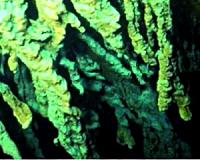| . |  |
. |
Kolkata (AFP) Dec 9, 2010 India's endangered Bengal tiger is dwindling not only in numbers, but also in stature, according to a recent survey that suggests the famed big cats are getting physically smaller. Experts say the Bengal tiger is losing weight because of "stress" associated with environmental changes impacting their natural habitat in the Sunderban mangrove swamps on the India-Bangladesh border. A survey conducted by Indian wildlife officials showed that tigers in the Sunderbans were lighter and their body parts smaller compared to a decade ago. "We were surprised that animals, which otherwise look healthy, weighed only 98 kilos (215 pounds)," Subrata Mukherjee, director of the Sunderbans Tiger Reserve, told AFP on Thursday. "The average weight of an adult tiger should not be less than 140 kilos," he added. As well as human encroachment, experts point to rising sea levels which are increasing the salinity of the Sunderban swamp waters surrounding the delta of the Ganges, Brahmaputra and Meghna rivers in the Bay of Bengal. This has reduced the number of fresh water ponds which attract the tigers' main prey. "Spotted deer have become their main source of food, but the deer numbers are going down because of rising sea levels which is causing more flooding in the forest," said Pranabesh Sanyal, a tiger expert with the International Union for Conservation of Nature and Natural Resources. "So the tigers are physically stressed and, being under-fed and malnourished, they are straying into human habitats in search of goats and cows," Sanyal said. The last census done in Sunderbans in 2001-02 put the tiger numbers in Indian section of the mangrove forest at just 274.
Share This Article With Planet Earth
Related Links Darwin Today At TerraDaily.com
 New Microscopic Life Aboard The RMS Titanic
New Microscopic Life Aboard The RMS TitanicSevilla, Spain (SPX) Dec 09, 2010 A brand-new bacterial species has been found aboard the RMS Titanic, which is contributing to its deterioration. The discovery reveals a potential new microbial threat to the exterior of ships and underwater metal structures such as oil rigs. The researchers, who report their findings in the latest issue of the International Journal of Systematic and Evolutionary Microbiology, isolated the ... read more |
|
| The content herein, unless otherwise known to be public domain, are Copyright 1995-2010 - SpaceDaily. AFP and UPI Wire Stories are copyright Agence France-Presse and United Press International. ESA Portal Reports are copyright European Space Agency. All NASA sourced material is public domain. Additional copyrights may apply in whole or part to other bona fide parties. Advertising does not imply endorsement,agreement or approval of any opinions, statements or information provided by SpaceDaily on any Web page published or hosted by SpaceDaily. Privacy Statement |